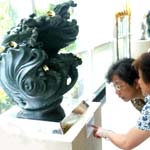
"Merry Gait" (Huan'ge Xiaobu) by Yang Xuejun from the
Guangzhou Arts Academy. |
The throngs of
local residents taking in the 2004 Guangzhou City Sculpture Invitation
Exhibition are an indication of local people's interest in the development of
sculpture in the city.
More than 210 sculptural works by 12 Chinese sculptors from 10 arts colleges
and nine sculpture institutes around the country are on display in the
exhibition, which will continue through July 4 at the Guangzhou Museum of Art.
Organizers hope that the eight-day exhibition will help get more Guangzhou
residents involved in the development of public arts in the city.
It also provides a window for local residents to see and appreciate
sculptural works from other major Chinese cities and enhance their sense of
creation and appreciation. The works, after all, reflect the local historical
and cultural characteristics of different cities.
The exhibition also offers a chance for local artists to share their concerns
with the public. There is a paucity of fine sculptural works in the city, even
though the local government has decided to enhance the development of public
arts in the city.
Guangzhou is the capital of South China's Guangdong Province, and is well
known for its outstanding economic and social development in the past two
decades.
It is also still one of the country's forerunners in the development of urban
sculpture.

Visitors are attracted to the "Sound of heaven" (Tianlai)
by Chen Xiaoyang from the Guangzhou Arts Academy, on display at the
Guangzhou Museum of Art for the 2004 Guangzhou City Sculpture Invitation
Exhibition. |
In the 1940s, the Guangzhou
Municipal Art Academy ran a department offering programmes in sculpture to help
cultivate local development of the art.
Ever since the policy of reform and opening up to the outside world was
adopted, Guangzhou has witnessed a surge in urban sculpture.
In the 1990s, in addition to putting up a number of sculptures around the
city, Guangzhou established a sculpture park, where a series of excellent
sculptures have been displayed. The park has become part of the city's image.
Sculptures in cities, which developed into a special art form during the
post-Greek period, become a reflection of a city's overall development.
However local artists point out that Guangzhou still lacks the fine city
sculptures that should represent its rapid economic and social development.
"It is a great pity that we see no such representative city sculpture in
popular public and scenic places, such as the Whampoa Military Academy or the
Mausoleum of the King of the South Yue Kingdom," said Yu Chang, director of the
Guangzhou Sculpture Academy.
In addition, the local artists have been creating works on commissions for
places other than their own home city. Pan He, a renowned local sculptor, said
that only about 1 per cent of his works were on display in the city.
It is not an exaggeration to say that the city has been losing the
masterpieces of its own artists.
The current exhibition is an attempt to remedy this. In fact, the city
launched a sculpture project this year, with plans to set up about 300
sculptural works in popular scenic spots and districts over the next three years
to showcase local cultural development.
The local government will invest 1 million yuan (US$120,900) every year to
upgrade the level of the city's public sculptures, sources with the Guangzhou
Culture Bureau said.
The first group of such works was put on display early this year in Shamian
Community and on Double Nine Street, both popular public places.
Meanwhile, the Guangzhou Municipal Urban Planning Bureau also plans to
establish a series of sculptural works in major public places around the city,
in a bid to upgrade the city's artistic image.
But Pan He suggests caution in pursuing this plan.
"The development of sculpture in the city should not be overdone, because
public sculpture is not just decorative art. It should follow the economic and
social development of the city," he said.
Pan, 79, also a tenured professor of the Guangzhou Academy of Fine Arts and
deputy director of the National Urban Sculptural Art Committee, has been engaged
in sculptural art for over 60 years.
More than 100 of his sculptures can be seen in over 60 city plazas both at
home and abroad.
The Guangdong provincial government has also established a Pan He Sculpture
Park, to protect his works and promote the appreciation of sculpture in the
province.
One of Pan's representative works is titled "Hard Days." It features a young
soldier listening to an old soldier playing the flute. Completed in 1956, the
work, enlarged in 1984 and now standing in front of the Shenzhen municipal
government building, suggests the pursuit of the revolutionary cause back in the
hard times before the founding of New China.
According to Pan, Guangdong was one of the first provinces in China to foster
the development of city sculpture during the 1980s.
It, in fact, took the lead at that time, moving a number of excellent works
from art academies or colleges to public places.
"In this way, the public have an opportunity to appreciate fine sculptures,
and more importantly, the sculptural works enhance the image of the city," he
said.
The "Five Rams" sculpture in the city's Yuexiu Park is widely regarded as a
symbol of Guangzhou's long history. The Memorial Sculpture for the Liberation of
Guangzhou in Haizhu Square reflects the city's history during the revolutionary
war. Another fine work is the bronze sculpture of Dr Sun Yat-sen in the Sun
Yat-sen Memorial Hall.
"They are classic works, but there are not enough such works in the city's
public places," said Pan.
"The city's sculptures should keep pace with the city's economic and social
development; otherwise, they will not reflect the ethos of the citiy," said
Pan.

